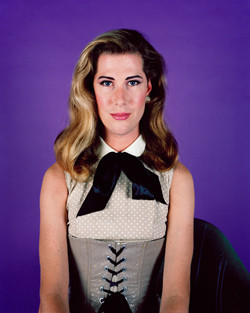Catherine Opie
26 Sep 2008 - 07 Jan 2009

© Catherine Opie
Justin Bond, 1993
Chromogenic print, edition of 8
20 x 16 inches
Courtesy the artist and Regen Projects, Los Angeles.
Justin Bond, 1993
Chromogenic print, edition of 8
20 x 16 inches
Courtesy the artist and Regen Projects, Los Angeles.
CATHERINE OPIE
September 26, 2008–January 7, 2009
Since the early 1990s, Catherine Opie has produced a complex body of photographic work, adopting such diverse genres as studio portraiture, landscape photography, and urban street photography to explore notions of communal, sexual, and cultural identity. From her early portraits of transgender people and performance artists to her expansive urban landscapes of cities like Minneapolis, Los Angeles, and New York, Opie has offered profound insights into the conditions in which communities form and the terms in which they are defined. All the while she has maintained a strict formal rigor, working in stark and provocative color as well as richly toned black-and-white.
The exhibition gathers works from Opie’s most important series in a major mid-career survey, starting with the series Being and Having (1991) and Portraits (1993–97), which first brought the artist to prominence, that celebrate queer communities in San Francisco and Los Angeles. In Houses (1995–96) Opie explores her interest in domestic architecture through portraits of Beverly Hills and Bel Air mansions in which each facade retains as distinct a character. Domestic (1995–98) offers a flip side to these works, moving inside to document lesbian families engaged in everyday household activities. Freeways (1994–95), the first of her black-and-white series, offers a richly formal meditation on the Los Angeles highway system. Continuing to document structures as icons and relics of human, and especially Southern Californian, culture, she continued with Mini-malls (1997–98), which focuses on billboards, signs, and architectural elements identifying various ethnic and cultural groups in Los Angeles shopping centers. This series inaugurated the ongoing project American Cities (1997–present), an extended group of panoramic black-and-white series that so far has explored Chicago, Minneapolis, New York, and St. Louis. Opie then looked toward more natural settings and the communities that exist there. Icehouses (2001) focuses on the way architectural structures accumulate human history but are at the mercy of the natural landscape on which they depend. Finally in Surfers (2003) the subjects are virtually engulfed in the vast and gloomy shoreline of Malibu, forever suspended on a tranquil sea, primed to catch the perfect ride that may never come. And most recently, Opie has turned to her own domestic life in In and Around Home (2004–05), Opie’s family becomes a microcosm for political and social issues at play on a wider level, its status as a queer family becoming subtly apparent over the course of the series.
September 26, 2008–January 7, 2009
Since the early 1990s, Catherine Opie has produced a complex body of photographic work, adopting such diverse genres as studio portraiture, landscape photography, and urban street photography to explore notions of communal, sexual, and cultural identity. From her early portraits of transgender people and performance artists to her expansive urban landscapes of cities like Minneapolis, Los Angeles, and New York, Opie has offered profound insights into the conditions in which communities form and the terms in which they are defined. All the while she has maintained a strict formal rigor, working in stark and provocative color as well as richly toned black-and-white.
The exhibition gathers works from Opie’s most important series in a major mid-career survey, starting with the series Being and Having (1991) and Portraits (1993–97), which first brought the artist to prominence, that celebrate queer communities in San Francisco and Los Angeles. In Houses (1995–96) Opie explores her interest in domestic architecture through portraits of Beverly Hills and Bel Air mansions in which each facade retains as distinct a character. Domestic (1995–98) offers a flip side to these works, moving inside to document lesbian families engaged in everyday household activities. Freeways (1994–95), the first of her black-and-white series, offers a richly formal meditation on the Los Angeles highway system. Continuing to document structures as icons and relics of human, and especially Southern Californian, culture, she continued with Mini-malls (1997–98), which focuses on billboards, signs, and architectural elements identifying various ethnic and cultural groups in Los Angeles shopping centers. This series inaugurated the ongoing project American Cities (1997–present), an extended group of panoramic black-and-white series that so far has explored Chicago, Minneapolis, New York, and St. Louis. Opie then looked toward more natural settings and the communities that exist there. Icehouses (2001) focuses on the way architectural structures accumulate human history but are at the mercy of the natural landscape on which they depend. Finally in Surfers (2003) the subjects are virtually engulfed in the vast and gloomy shoreline of Malibu, forever suspended on a tranquil sea, primed to catch the perfect ride that may never come. And most recently, Opie has turned to her own domestic life in In and Around Home (2004–05), Opie’s family becomes a microcosm for political and social issues at play on a wider level, its status as a queer family becoming subtly apparent over the course of the series.
